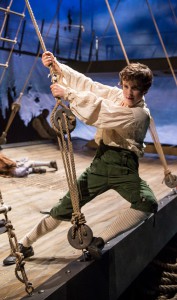By Alexandra Garfield
Set sail with the Lookingglass Theater for the best stage production of Treasure Island you may ever see.
The swashbuckling adventure and shocking betrayals sizzling through Robert Louis Stevenson’s best-known novel, come to life on the stage at the Water Tower.
Classic characters like Long John Silver and Jim Hawkins leap off the stage and into the parts of your brain that still hold onto childhood fantasies.
This impeccably staged and performed show ushers you into a good, old-fashioned adventure. It hauls you aboard a pirate ship to swing from the rigging and hunt for buried treasure.
The action carries you along despite all the reasons why this novel is difficult to adapt to the stage. But Lookingglass Theater’s own Mary Zimmerman has never been one to back away from a challenge.
As both director and playwright, Zimmerman delights audiences once again with Robert Louis Stevenson’s classic voyage. Her work has met critical acclaim across the country. She once again finds elegant solutions to the physical and narrative challenges of adapting this novel to the sage.
“Squire Trelawney, Dr. Livesey, and the rest of these gentlemen having asked me to write down the whole particulars about Treasure Island, from the beginning to the end, keeping nothing back but the bearings of the island.”
-Robert Louis Stevenson, Treasure Island
The biggest challenge inherent to the plot is that Jim Hawkins, the narrator of the story, is a 13-year-old boy. The number of genuinely talented child actors out there looking for work may not surprise you, but one who can carry an entire show night after night takes some careful casting.

The actor chosen for this lead role, John Babbo, of Oak Park, immerses the audience in Stevenson’s fantasy from his first words and holds them, spellbound until the last call of “pieces of eight.”
At just 15, he boasts an impressive resume, including roles on stage in New York and Chicago and in TV shows such as Chicago Fire and Sense8. His grounded and thoughtful performance leaves you double-checking your program to confirm that he’s not an older actor in disguise.
Despite his youth, Babbo not only pulls off a riveting portrayal , but captivates the audience with lush descriptions of settings and action.
“The worst dreams that ever I have are when I hear the surf booming about its coasts or start upright in bed with the sharp voice of Captain Flint still ringing in my ears: “Pieces of eight! Pieces of eight,” Babbo says at the end of the play.
He guides the audience through scene changes and describes a full visual world despite the sparse use of set pieces.
There are times when the character’s lower-class English accent becomes a little garbled, though, causing theater-goers to miss a few words here and there. This is a problem that actors three times his age struggle with across the country, however, and does not take away from the flow of the story.
Between Babbo and Zimmerman, Jim Hawkins’ first person narration seems like a natural part of the show rather than an awkward remnant from the novel.
The most technical problem is that a large portion of the show’s action takes place aboard at 18th century ship.
Zimmerman’s solution is so creative and simple that it will take your breath away. She turns the entire stage into the ship.

The stage is centered in Lookingglass’s black-box theater, with audience members on three sides and a scrim behind, torn to look like sailcloth. The curved stage itself is suspended from the ceiling, with ropes knotted to look like the rigging of a ship. The stairs from the small upper level double as an anchor for the stage, keeping it level for most of the show.
When the stairs are removed, however, the stage can swing back and forth to imitate the swaying deck of a sailing vessel.
The added emotional pull of classic sea shanties such as Roll the Old Chariot and Johnny, Leave Her, leave you wanting to board the nearest ship bound for the South Pacific.
In an interview for the program, Zimmerman said that this is exactly why this story still resonates over 100 years after its publication.
“I think we have dual needs: a need for security and knowing how the story ends. But also, there’s a wild part of us that has that wild longing all the time to be tested, to have life and death situations, to have to use our wits… to have to act to save yourself and save the crew,” Zimmerman says.
This desire for adventure seemed to resonate with even the youngest members of the audience. Two blond-haired boys, who wiggled in their seats during the first few scenes, soon became entranced by swarthy pirates and promises of buried treasure. They watched spellbound through the rest of the play. At the end, the uncovered gold illuminated their eager faces and the smiling faces of their parents on either side.

Mary Zimmerman’s Treasure Island runs through January 31, 2016 at Chicago’s historic Water Tower Water Works, 821 N. Michigan Ave. This production is co-produced by Lookingglass Theater and Berkeley Repertory Theater. Tickets: $35-$85


